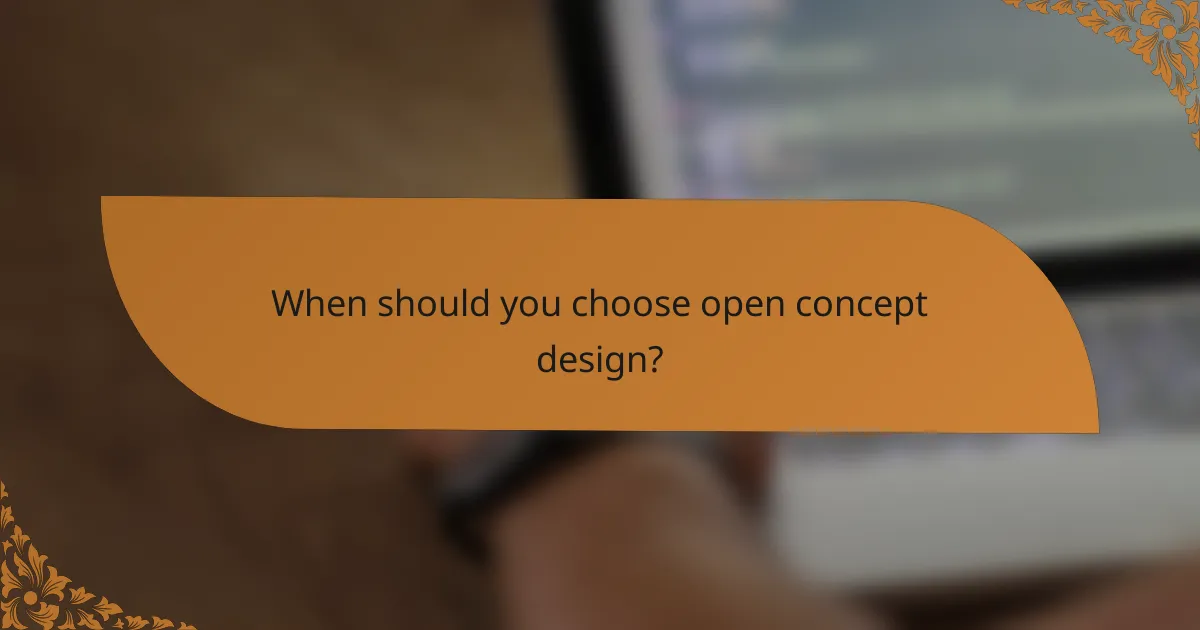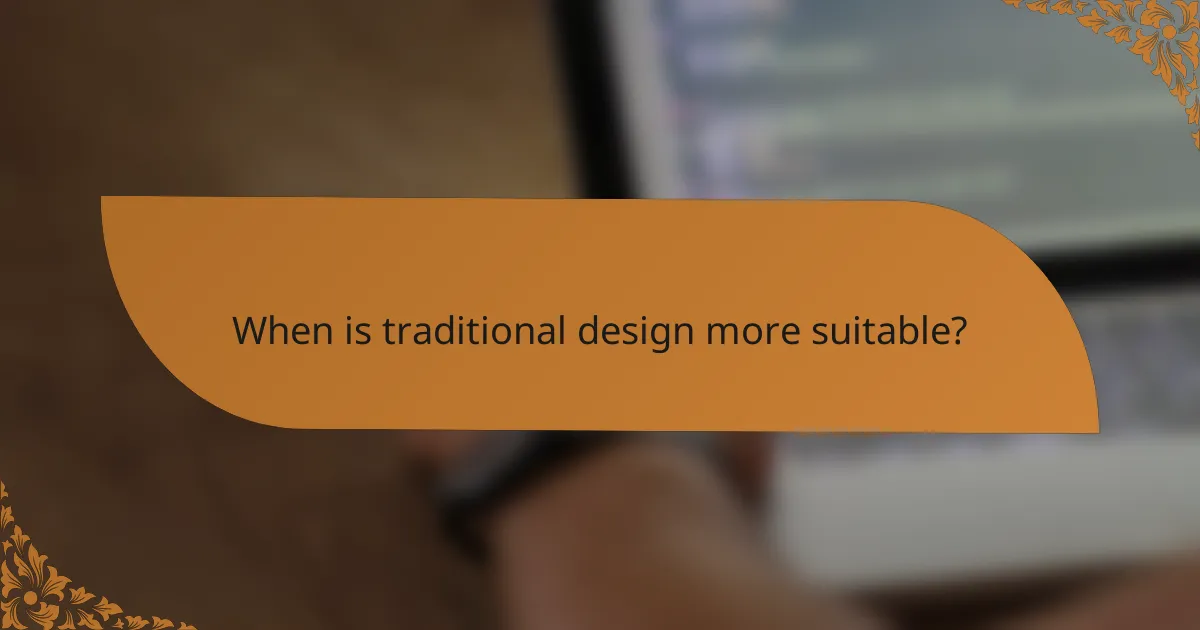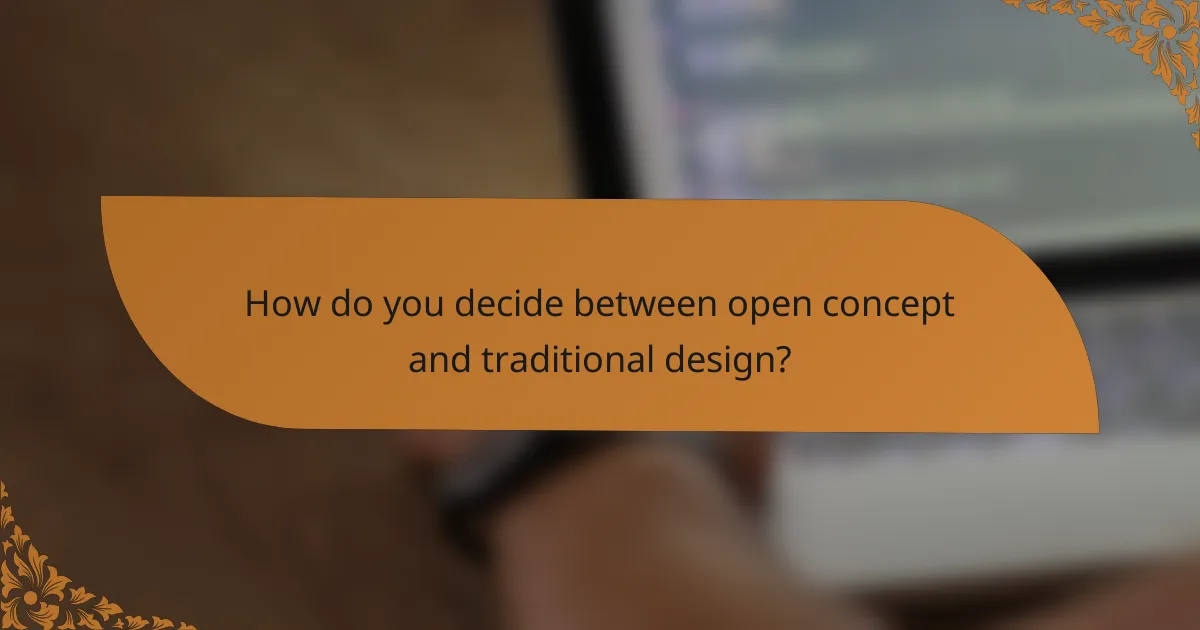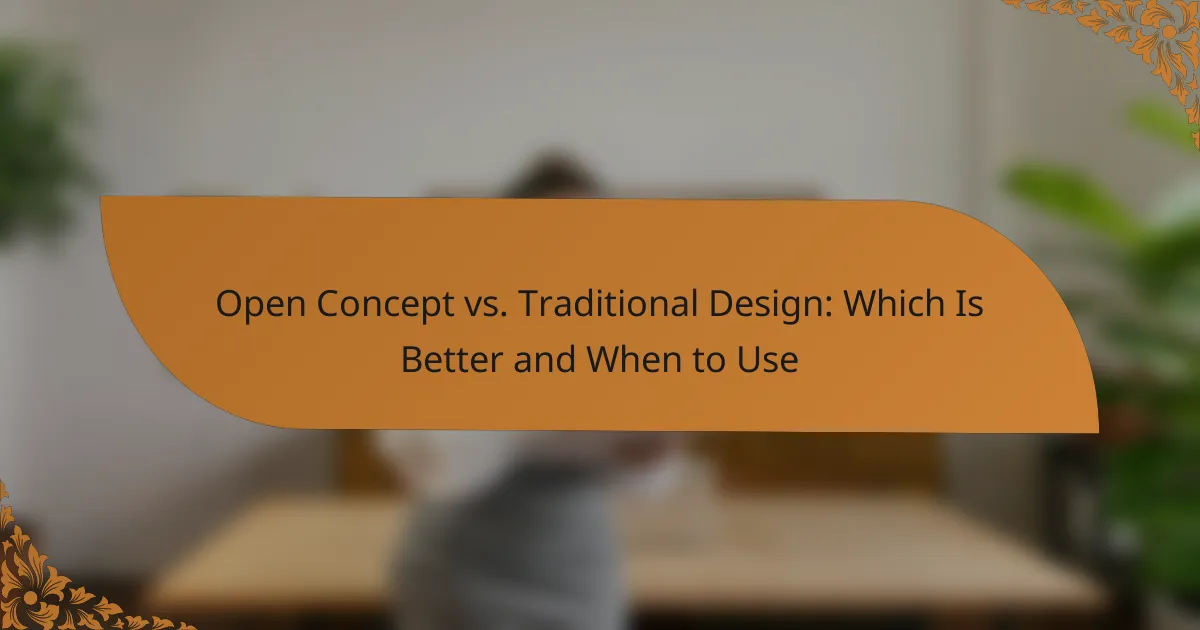Choosing between open concept and traditional design depends on your space needs and lifestyle preferences. Open concept layouts foster connectivity and an inviting atmosphere, making them ideal for modern living and social interactions. In contrast, traditional design emphasizes defined spaces, offering enhanced privacy and a structured environment that can be beneficial for specific functions and aesthetics.

What are the benefits of open concept design?
Open concept design offers several advantages, including improved flow and connectivity between spaces. This layout can create a more inviting atmosphere, making it ideal for both residential and commercial environments.
Increased natural light
Open concept designs typically allow for more natural light to penetrate throughout the space. With fewer walls obstructing windows, light can travel freely, brightening the entire area and reducing the need for artificial lighting during the day.
To maximize natural light, consider using large windows or glass doors that open to outdoor areas. This not only enhances illumination but can also create a seamless transition between indoor and outdoor spaces.
Enhanced social interaction
One of the key benefits of open concept design is the promotion of social interaction. By eliminating barriers, family members or colleagues can easily communicate and engage with one another, fostering a sense of community.
In homes, this layout encourages gatherings and shared activities, while in offices, it can lead to increased collaboration and teamwork. However, it’s important to balance openness with designated quiet areas to avoid distractions.
Flexible space usage
Open concept spaces offer flexibility in how areas are utilized. Without fixed walls, homeowners and businesses can rearrange furniture and adapt the layout to suit various needs, from hosting events to creating workspaces.
Consider using movable partitions or multifunctional furniture to further enhance this flexibility. This adaptability can be particularly beneficial in smaller spaces, where maximizing every square foot is crucial.

What are the advantages of traditional design?
Traditional design offers several advantages, particularly in terms of functionality and aesthetics. It emphasizes defined spaces, which can enhance privacy and create a more structured environment.
Defined spaces for privacy
One of the primary benefits of traditional design is the creation of defined spaces that promote privacy. Rooms are typically enclosed, allowing individuals to retreat without distractions from others. This layout is particularly beneficial in homes where family members or roommates may need personal space.
In office settings, traditional designs can facilitate focused work by providing separate areas for meetings and individual tasks. This separation helps reduce noise and interruptions, contributing to a more productive atmosphere.
Classic aesthetic appeal
Traditional design is often characterized by its classic aesthetic, which can evoke a sense of warmth and familiarity. Elements such as crown molding, hardwood floors, and rich color palettes contribute to a timeless look that many find appealing.
This style can enhance the value of a property, as it tends to attract buyers who appreciate its elegance and charm. Incorporating traditional design elements can create a cohesive look that feels both inviting and sophisticated.
Better sound insulation
Traditional design often includes solid walls and doors, which can provide superior sound insulation compared to open concept layouts. This feature is particularly advantageous in urban environments where external noise can be a concern.
By minimizing sound transfer between rooms, traditional designs help maintain a peaceful living or working environment. This can be crucial for activities that require concentration, such as studying or professional meetings.

When should you choose open concept design?
Open concept design is ideal when you want to create a spacious, airy feel in your home. This layout is particularly beneficial for modern lifestyles, smaller homes, and social gatherings, allowing for fluid movement and interaction among spaces.
For modern lifestyles
Open concept design suits contemporary living by fostering a sense of connection among family members and guests. With fewer walls, this layout encourages interaction and collaboration, making it easier to multitask, such as cooking while entertaining. Consider incorporating multifunctional furniture to maximize space efficiency.
In smaller homes
In smaller homes, open concept design can make areas feel larger and more inviting. By eliminating unnecessary walls, you can create a seamless flow between rooms, which can visually expand the space. Use light colors and strategic lighting to enhance this effect, making the home feel more spacious and welcoming.
For entertaining purposes
Open concept layouts are excellent for entertaining, as they allow guests to move freely between different areas. This design fosters a social atmosphere, making it easier to host gatherings without feeling cramped. Consider adding a large island or bar area in the kitchen to facilitate conversation and interaction during events.

When is traditional design more suitable?
Traditional design is often more suitable in environments where privacy, defined spaces, and a classic aesthetic are prioritized. This design style is particularly beneficial for larger families, historic homes, and formal settings, where the layout and ambiance play a crucial role in functionality and comfort.
For larger families
Traditional design is ideal for larger families as it provides distinct rooms for various activities, allowing for better organization and privacy. Separate spaces like living rooms, dining areas, and playrooms help manage noise levels and create a sense of order.
When designing for a larger household, consider incorporating features like a spacious kitchen with an adjoining dining room. This setup encourages family gatherings while maintaining the benefits of separate areas for different activities.
In historic homes
In historic homes, traditional design respects the architectural integrity and character of the property. This approach often emphasizes classic materials, detailed moldings, and period-appropriate furnishings that enhance the home’s original charm.
When renovating or decorating a historic home, prioritize preserving original features such as fireplaces, built-in cabinetry, and hardwood floors. This not only maintains the home’s value but also creates a cohesive and inviting atmosphere.
For formal settings
Traditional design is well-suited for formal settings, such as dining rooms or offices, where a polished and sophisticated look is desired. The use of rich colors, elegant furnishings, and classic decor elements can create an atmosphere of refinement.
To achieve a formal look, focus on symmetry in furniture placement and choose high-quality materials like wood and upholstery. Incorporating elements such as chandeliers or ornate rugs can further enhance the elegance of the space.

What are the costs associated with each design style?
The costs associated with open concept and traditional design styles can vary significantly based on factors like location, materials, and the extent of renovations. Generally, open concept renovations may require more structural changes, while traditional designs often involve cosmetic updates, impacting overall expenses.
Open concept renovation costs
Open concept renovations typically involve removing walls and possibly reinforcing structures, which can lead to higher costs. Homeowners can expect to spend anywhere from $15,000 to $50,000 or more, depending on the size of the space and the complexity of the project.
When planning an open concept renovation, consider additional expenses such as electrical and plumbing adjustments, as well as new flooring and lighting fixtures. It’s crucial to budget for these elements to avoid unexpected costs.
Traditional design renovation costs
Traditional design renovations usually focus on cosmetic changes like painting, flooring, and cabinetry, which can be more budget-friendly. Costs for these updates can range from $5,000 to $20,000, depending on the materials chosen and the scale of the work.
Homeowners should keep in mind that while traditional renovations may be less expensive upfront, they might not provide the same level of open space and light as an open concept design. Prioritize your needs and lifestyle when deciding on the best approach for your home.

How do you decide between open concept and traditional design?
Choosing between open concept and traditional design depends on your lifestyle, preferences, and how you use your space. Open concept layouts promote interaction and flexibility, while traditional designs offer defined areas and privacy.
Assess lifestyle needs
Begin by evaluating your daily activities and how you interact with family or guests. If you frequently entertain or enjoy a communal atmosphere, an open concept may suit you better. Conversely, if you value privacy or have specific needs for quiet spaces, a traditional design could be more appropriate.
Consider the age and needs of household members as well. Families with young children might benefit from open spaces for supervision, while older adults may prefer the separation that traditional layouts provide. Think about how each design aligns with your lifestyle and future plans.
Finally, reflect on your work-from-home situation. An open layout can foster collaboration but may also lead to distractions. A traditional design can create dedicated workspaces, enhancing focus and productivity. Weigh these factors carefully to determine the best fit for your needs.
